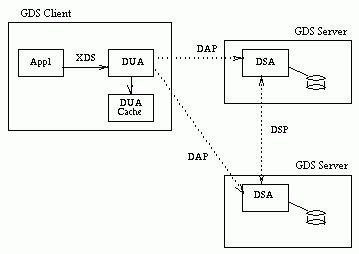What Is GDS?
There are several components that work together to provide the DCE Global Directory Service:
· The Directory System Agent (DSA)
This process runs on the GDS Server machine and manages the GDS database. It is the server side of GDS. In order to handle simultaneous requests from different users, the GDS Server machine can run several DSA processes.
· The Directory User Agent (DUA)
The DUA is a library that implements the GDS client; this library is present on all GDS client machines.
· The Directory User Agent Cache
This process keeps a cache of information obtained from DSAs. One DUA cache runs on each client machine and is used by all the users on that machine. The DUA cache contains copies of recently accessed object entries and information about DSAs. The programmer specifies which information should be cached, and it is possible to bypass the DUA cache to obtain information directly from a DSA. This is desirable, for example, when the user wants to make sure the information obtained is up-to-date.
· The C-Stub and S-Stub
The C-Stub process runs on each client machine and manages communications with DSAs. It implements the upper layers of the ISO protocol stack (see GDS Relation to Standards ). Its function is similar to the RPC runtime (GDS uses OSI protocols instead of DCE RPC). The S-Stub is similar to the C-Stub, except it runs on the server machine and manages its communications with DUAs and other DSAs.
· Shadow update and cache update processes
Unlike the processes listed previously, which run continuously, the processes for updating replicas in DSAs and DUA Caches run as needed and then terminate. The shadow update process runs on the GDS Server machine; the cache update process runs on GDS client machines.
· The GDS administration programs
DCE GDS continues to provide the following three programs for administering its service. One, gdssysadm, supports administration of the local GDS installation, such as configuration, server activation, and backup. The gdsditadm program supports remote administration of the contents of a GDS database. Finally, the gdscacheadm program supports the administration of the contents of the local DUA cache.
For Release 1.1, GDS also provides the gdscp and gdssetup programs. The gdscp program allows the administrator to enter object administration functions using command-line and interactive modes. It can be used as an alternative to the Object Administration menu interface and part of the Cache Administration menu interface of the GDS administration program.
The gdssetup command provides the administrator with an interface to simplify the process of creating and initializing a directory configuration. The other method of creating and initializing a directory configuration requires that the administrator perform initialization steps by using the masks of the gdsditadm program either manually or by using batch file scripts.
The advantages of both of these programs are described in the OSF DCE GDS Administration Guide and Reference.
The following figure shows the interaction between the Directory Service application, the XDS interface, and the GDS client and server. The GDS client and server use the Directory Access Protocol (DAP) to communicate. The GDS servers use the Directory System Protocol (DSP) to communicate with one another. DAP and DSP perform functions similar to the function that the DCE RPC protocols perform in other DCE services. The DAP and DSP protocols are defined in the X.500 standard, enabling worldwide interoperability among directory services.
GDS Components
